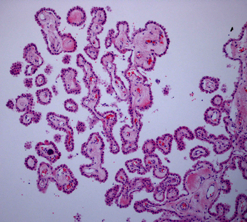Choroid plexus
(Redirected from Choroid plexuses)
Choroid Plexus
The choroid plexus is a plexus of cells that produces the cerebrospinal fluid (CSF) in the ventricles of the brain. It is a vital component of the central nervous system (CNS), playing a key role in the production and regulation of CSF, which in turn is crucial for protecting the brain, removing waste products, and providing a stable environment for the brain's neurons.
Structure[edit | edit source]
The choroid plexus consists of a layer of epithelial cells that are attached to the pia mater, one of the meningeal layers surrounding the brain. These cells are highly specialized and are involved in the secretion of CSF. The choroid plexus is found in all four ventricles of the brain, but it is most prominent in the lateral ventricles and the fourth ventricle.
Function[edit | edit source]
The primary function of the choroid plexus is the production of CSF. This fluid circulates through the ventricular system of the brain and the spinal cord, providing a cushioning effect that protects the CNS from trauma. Additionally, CSF serves as a medium for the exchange of nutrients and waste products between the blood and the brain tissue. The choroid plexus also plays a role in maintaining the blood-brain barrier, a selective barrier that prevents certain substances in the blood from entering the brain.
Clinical Significance[edit | edit source]
Alterations in the function or structure of the choroid plexus can lead to various medical conditions. For example, an overproduction of CSF can result in hydrocephalus, a condition characterized by an abnormal accumulation of CSF in the ventricles of the brain. This can cause increased intracranial pressure and may lead to brain damage if not treated. Conversely, a reduction in CSF production can lead to intracranial hypotension, characterized by low pressure within the skull, which can cause headaches and other neurological symptoms.
Choroid plexus tumors, while rare, can also occur. These can be benign (such as choroid plexus papilloma) or malignant (such as choroid plexus carcinoma). Such tumors can affect CSF dynamics and may require surgical removal or other treatments.
Research[edit | edit source]
Research on the choroid plexus continues to uncover its complex roles beyond CSF production, including its involvement in immune system regulation within the CNS and its potential as a therapeutic target for various neurological diseases.
Search WikiMD
Ad.Tired of being Overweight? Try W8MD's physician weight loss program.
Semaglutide (Ozempic / Wegovy and Tirzepatide (Mounjaro / Zepbound) available.
Advertise on WikiMD
|
WikiMD's Wellness Encyclopedia |
| Let Food Be Thy Medicine Medicine Thy Food - Hippocrates |
Translate this page: - East Asian
中文,
日本,
한국어,
South Asian
हिन्दी,
தமிழ்,
తెలుగు,
Urdu,
ಕನ್ನಡ,
Southeast Asian
Indonesian,
Vietnamese,
Thai,
မြန်မာဘာသာ,
বাংলা
European
español,
Deutsch,
français,
Greek,
português do Brasil,
polski,
română,
русский,
Nederlands,
norsk,
svenska,
suomi,
Italian
Middle Eastern & African
عربى,
Turkish,
Persian,
Hebrew,
Afrikaans,
isiZulu,
Kiswahili,
Other
Bulgarian,
Hungarian,
Czech,
Swedish,
മലയാളം,
मराठी,
ਪੰਜਾਬੀ,
ગુજરાતી,
Portuguese,
Ukrainian
Medical Disclaimer: WikiMD is not a substitute for professional medical advice. The information on WikiMD is provided as an information resource only, may be incorrect, outdated or misleading, and is not to be used or relied on for any diagnostic or treatment purposes. Please consult your health care provider before making any healthcare decisions or for guidance about a specific medical condition. WikiMD expressly disclaims responsibility, and shall have no liability, for any damages, loss, injury, or liability whatsoever suffered as a result of your reliance on the information contained in this site. By visiting this site you agree to the foregoing terms and conditions, which may from time to time be changed or supplemented by WikiMD. If you do not agree to the foregoing terms and conditions, you should not enter or use this site. See full disclaimer.
Credits:Most images are courtesy of Wikimedia commons, and templates, categories Wikipedia, licensed under CC BY SA or similar.
Contributors: Prab R. Tumpati, MD




